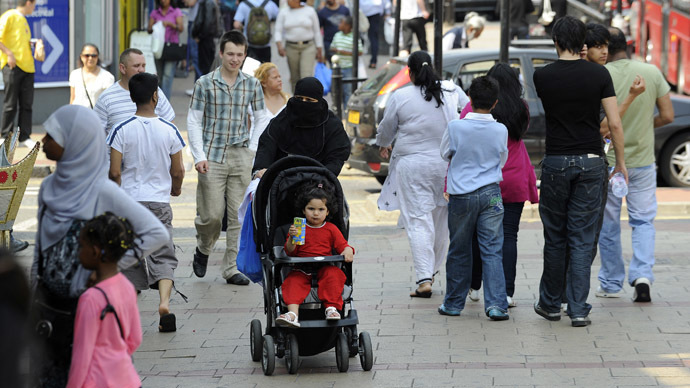EU immigration: Don’t target the immigrants, blame turbo-capitalism

What’s going on – why has EU immigration become such a big issue? To answer the question, we need to look back at the political and economic changes that have occurred over the past 30 years.
Switzerland has voted narrowly in a referendum to bring back strict quotas for immigration from European Union countries. In Norway, the Progress Party, which serves in the current governing coalition, has called for the country to copy the Swiss and hold its own referendum on immigration from the EU. Meanwhile, in the UK, Prime Minister David Cameron has said he wants to see “tougher measures” on migration from the EU.
Across the European continent, parties that call for stricter curbs on immigration, such as the UK Independence Party in Britain, have been gaining in strength. It’s not just parties of the right that are taking a tougher line: in Britain, Labour leader Ed Miliband has said that his party “got it wrong” when it allowed uncontrolled immigration from new EU states in 2004.
The large increases in EU migration haven’t just happened out of the blue – it is a feature of modern turbo-capitalism and the shift in economic model from one which put the interests of the majority first, to one that benefits the 1 percent.
For over 30 years, from the end of the Second World War, European countries, both in the west and the east, operated under economic systems in which full employment was governments’ stated aim. In the 1979 general election in Austria, Socialist Chancellor Bruno Kreisky said that he would rather the government run up a deficit than people lose their jobs.

"Hundreds of thousands unemployed matter more than a few billion schillings of debt," he said. What a contrast to the views of the European elite of today, who put cutting deficits before jobs.
A feature of the European economies in this post-war era was a
large state-owned sector. In communist countries, all large-scale
enterprises were in public ownership. These state-owned companies
were paternalistic and offered workers not just secure employment
but other fringe benefits too, such as subsidized canteens,
crèches, sports facilities and holidays in company-owned
accommodation. In western Europe, too, the public sector was
extensive. In Britain, by the late 1970s it included coal, steel
and shipbuilding, public transportation, the motor industry, the
energy sector, water, cross-channel ferries, hotels and
telecommunications. It was a similar story in other western
European countries too.
These state-owned companies were a feature of the pre-neoliberal
age.
The nationalized companies' aim was not profit maximization at the expense of all other considerations – they pursued wider social goals too. They were a key reason why unemployment across Europe was much lower than today.
But starting in 1979 in Britain, all this changed.
If the pre-1979 economic models – communism in eastern Europe,
and mixed economies with a high level of state ownership in the
west, can be described as majoritarian systems – i.e. ones which
put the economic interests of the majority first, the model which
followed was minoritarian – in that it was about putting the
interests of the 1 percent first. The neo-liberal reforms of the
Thatcher government in Britain helped usher in the era of
turbo-capitalism.
Exchange controls were abolished. Financial services were
deregulated. And most importantly of all, state-owned enterprises
were privatized. These economic policies, when copied elsewhere,
led to higher long-term unemployment in western Europe, but the
impact was even more disastrous in eastern Europe after the fall
of communism in 1989.

Had communism been replaced by the mixed economy model which operated in western Europe in the post-war period, one in which governments strove to maintain full employment, and maintained a large state-owned sector, there wouldn’t have been a problem. But the western elites – and the international institutions that represent their interests, such as the IMF and World Bank, had already decided to jettison that model and so the countries of the east went straight from communism to neo-liberalism.
Their economies were radically restructured with mass privatization of state-owned enterprises. The impact that this had on employment levels in eastern Europe was catastrophic.
“The unparalleled peacetime contraction of post-communist economies can only be compared to the Great Depression of the 1930s,” Hungarian economist Laszlo Andor wrote in The Guardian in 2004. “Luckier countries like Hungary lost only about 20 percent of their national income in the years after 1989, while the GDP of others fell by 30-40 percent. Poland was first to recover its 1989 output level, in 1997; the rest only managed to do so in 2000 or even later.” Interestingly, Andor is now Commissioner for Employment, Social Affairs and Inclusion in the European Commission.
Millions of people in eastern Europe who would have been employed in state-owned companies were laid off as private companies – often from the west – took over and slashed the workforce as a way to maximize profits. Many factories were closed down and the land sold off by asset strippers. In the Hungarian capital, Budapest, the historic building of Magyar Optikai Muvek (Hungarian Optical Works), a world famous company that employed thousands of people, making excellent optical equipment, was demolished to make way for a shopping mall with a Citibank, McDonald’s and Starbucks.
It’s been a similar story across eastern Europe as economies were radically “restructured” to benefit foreign “investors” and multinationals. With greatly reduced employment possibilities at home due to the economic changes, a whole generation of eastern Europeans have had no option but to leave their countries to try and make a living elsewhere.

A 2011 census showed that 579,000 Poles were living in Britain, 10 times more than a decade earlier. In Poland, unemployment among the under 25s was a whopping 27.4 percent in December 2013 (and 30 percent for young women). Just imagine how much higher the figure would have been if young Poles had stayed in their country. In Hungary, 24.6 percent of people under 25 are unemployed, while in Bulgaria it’s 29.4 percent (and 33 percent for men under 25).
This mass exodus from the east – brought about by lack of employment opportunities at home – is one of the great non-stories of modern times.
A huge media fuss was made about the so-called “brain drain” from Britain to the US in the 1970s, when the top rate of income tax was 83 percent in Britain, but little said about the much bigger migration flows that brutal neoliberal policies have caused in Europe.
While eastern European immigrants are often scapegoated there is little, if any, analysis of why they are leaving their countries in such large numbers. To do that would mean countering the dominant neoliberal narrative, which says that following the fall of communism eastern European economies have been great success stories. But if the economies in the east really are so successful following “restructuring,” why have millions of eastern Europeans left their homelands?
The question we need to ask is who has benefited most from this massive rise in European migration. The answer quite clearly, is capital.

As Fred Goldstein puts it in his book, “Low Wage Capitalism”: “Sections of the ruling class tolerate, encourage and take advantage of this influx of immigrants, not only for the purpose of filling a labor shortage or to settle territory, but also to artificially increase the reserve army of labor, an army of vulnerable workers who are forced to work at substandard wages. The principal aim of permitting and fostering immigration under imperialism is to greatly increase competition among workers and keep downward pressure on wages.” The same elites in the west who ordered the economic restructuring in the east which triggered the massive exodus of workers from that region, benefit from the immigration for the reasons Goldstein outlines.
If people in western countries feel that the level of immigration is too high, that it is putting too much pressure on services and infrastructure, and that it is leading to a downward push on wages, then they should not be angry with the immigrants. Instead, they should get even with the economic and political elites who changed a system (that worked well for the majority) to one which benefits the 1 percent, for their own selfish interests.
The statements, views and opinions expressed in this column are solely those of the author and do not necessarily represent those of RT.
The statements, views and opinions expressed in this column are solely those of the author and do not necessarily represent those of RT.













